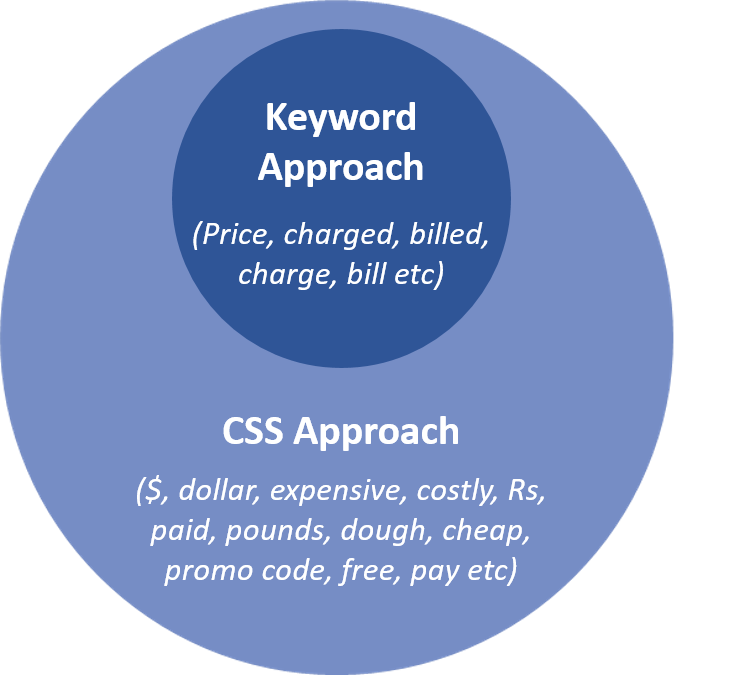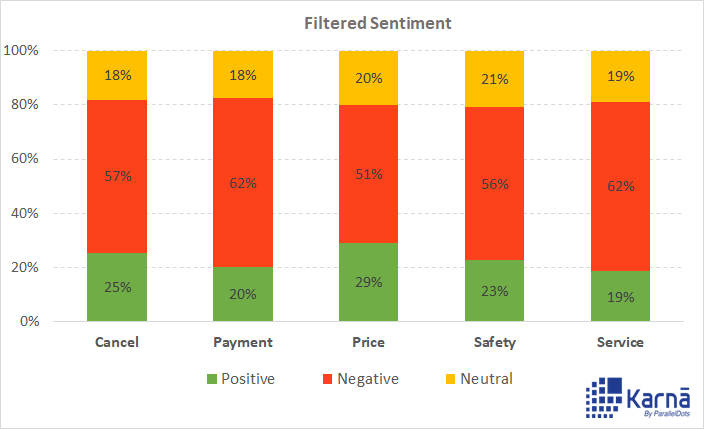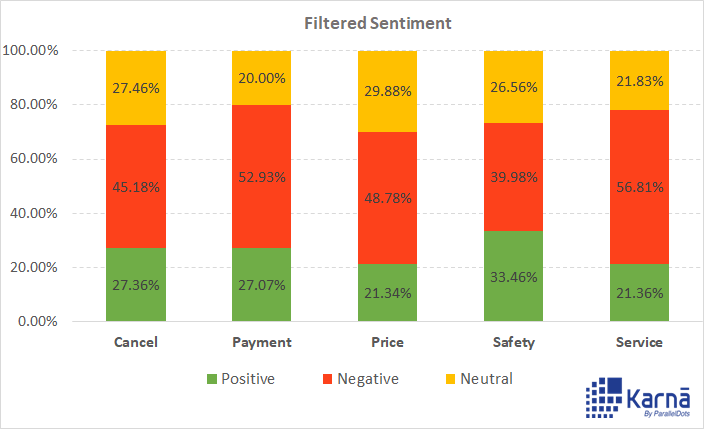Latest news about Bitcoin and all cryptocurrencies. Your daily crypto news habit.
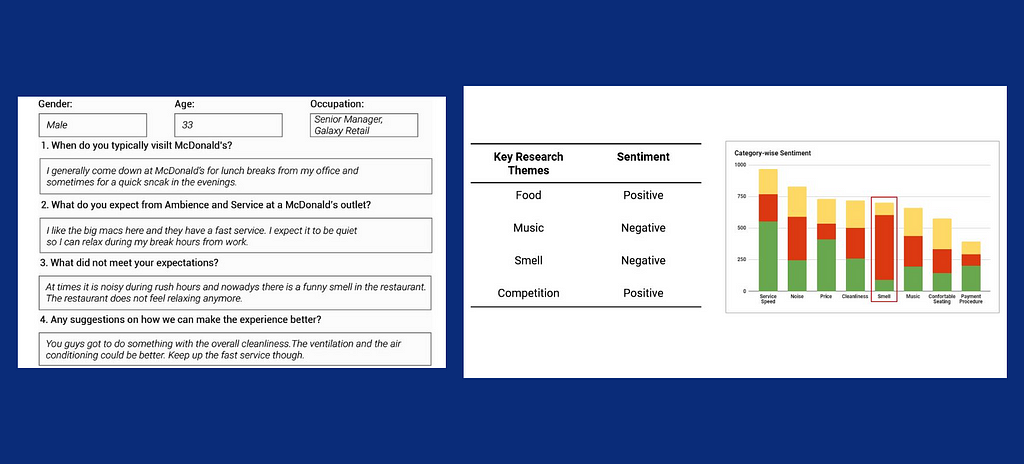
With the recent advances in deep learning, the ability of algorithms to analyze text has improved considerably. Now analyzing digital and social media is not restricted to just basic sentiment analysis and count based metrics. Creative use of advanced artificial intelligence techniques can be an effective tool for doing in-depth research. We believe it is important to classify incoming customer conversation about a brand based on following lines:
- Key aspects of a brand’s product and service that customers care about.
- Users’ underlying intentions and reactions concerning those aspects.
These basic concepts when used in combination, become a very important tool for analyzing millions of brand conversations with human-level accuracy. In the post, we take the example of Uber and demonstrate how this works. Read On!
Text Classifier — The basic building blocks
1. Sentiment Analysis
Sentiment analysis is the most common text classification tool that analyses an incoming message and tells whether the underlying sentiment is positive, negative or neutral. You can input a sentence of your choice and gauge the underlying sentiment by playing with the demo here.
Emotion Analysis
Emotion Analysis can accurately detect the emotion from any textual data. People voice their opinion, feedback, and reviews on social media, blogs, and forums. Marketers and customer support can leverage the power of Emotion Detection to read and analyze emotions attached with the textual data. Our Emotion Analysis classifier is trained on our proprietary dataset and tells whether the underlying emotion behind a message is: Happy, Sad, Angry, Fearful, Excited, Funny or Sarcastic.
Intent Analysis
Intent analysis steps up the game by analyzing the user’s intention behind a message and identifying whether it relates an opinion, news, marketing, complaint, suggestion, appreciation or query.
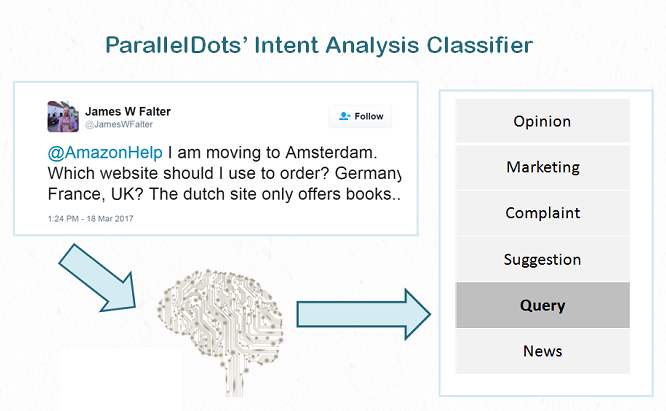 Analyzing intent of textual data
Analyzing intent of textual data
Contextual Semantic Search(CSS)
Now, this is where things get really interesting. To derive actionable insights, it is important to understand what aspect of the brand is a user discussing about. For example, Amazon would want to segregate messages that related to late deliveries, billing issues, promotion related queries, product reviews etc. But how can one do that?
We introduce an intelligent smart search algorithm called Contextual Semantic Search (a.k.a. CSS). The way CSS works is that it takes thousands of messages and a concept (like Price) as input and filters all the messages that closely match with the given concept. The graphic shown below demonstrates how CSS represents a major improvement over existing methods used by the industry.
A conventional approach for filtering all Price related messages is to do a keyword search on Price and other closely related words like (pricing, charge, $, paid). This method, however, is not very effective as it is almost impossible to think of all the relevant keywords and their variants that represent a particular concept. CSS on the other hand just takes the name of the concept (Price) as input and filters all the contextually similar even where the obvious variants of the concept keyword are not mentioned.
For the curious people, we would like to give a glimpse of how this works. An AI technique is used to convert every word into a specific point in the hyperspace and the distance between these points is used to identify messages where the context is similar to the concept we are exploring. A visualization of how this looks under the hood can be seen below:
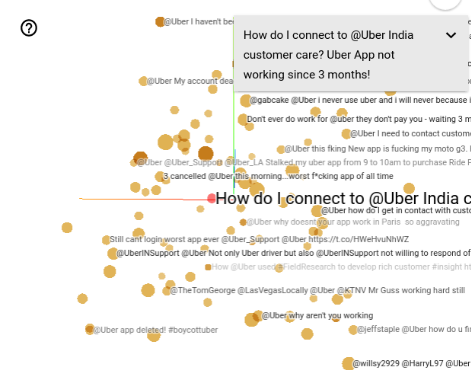 Visualizing contextually related Tweets
Visualizing contextually related Tweets
Time to see CSS in action and how it works on textual data below:
The algorithm classifies the messages as being contextually related to the concept called Price even though the word Price is not mentioned in the messages.
Uber: A deep dive analysis
We analyzed the online conversations happening on digital media about a few product themes: Cancel, Payment, Price, Safety, and Service.
For a wide coverage of data sources, we took data from latest comments on Uber’s official Facebook page, Tweets mentioning Uber and latest news articles around Uber. Here’s a distribution of data points across all the channels:
- Facebook: 34,173 Comments
- Twitter: 21,603 Tweets
- News: 4,245 Articles
Analyzing sentiments of user conversations can give you an idea about overall brand perceptions. But, to dig deeper, it is important to further classify the data with the help of Contextual Semantic Search.
We ran the Contextual Semantic Search algorithm on the same dataset, taking the aforementioned categories in an account (Cancel, Payment, Price, Safety, and Service).
Sentiment Analysis
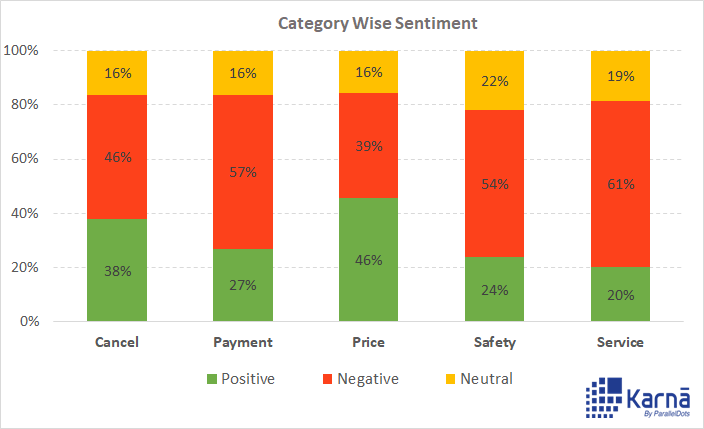 Breakdown of Sentiment for Categories
Breakdown of Sentiment for Categories
Noticeably, comments related to all the categories have a negative sentiment majorly, bar one. The number of positive comments related to Price has outnumbered the negative ones. To dig deeper, we analyzed the intent of these comments. Facebook being a social platform, the comments are crowded random content, news shares, marketing and promotional content and spam/junk/unrelated content. Have a look at the intent analysis on the Facebook comments:
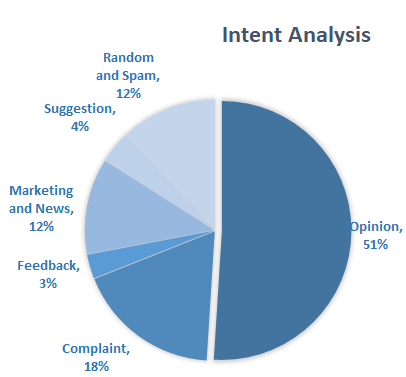 Intent analysis of Facebook comments
Intent analysis of Facebook comments
Thus, we removed all such irrelevant intent categories and reproduced the result:
There is a noticeable change in the sentiment attached to each category. Especially in Pricerelated comments, where the number of positive comments has dropped from 46% to 29%.
Sentiment Analysis
A similar analysis was done for crawled Tweets. In the initial analysis Payment and Safetyrelated Tweets had a mixed sentiment.
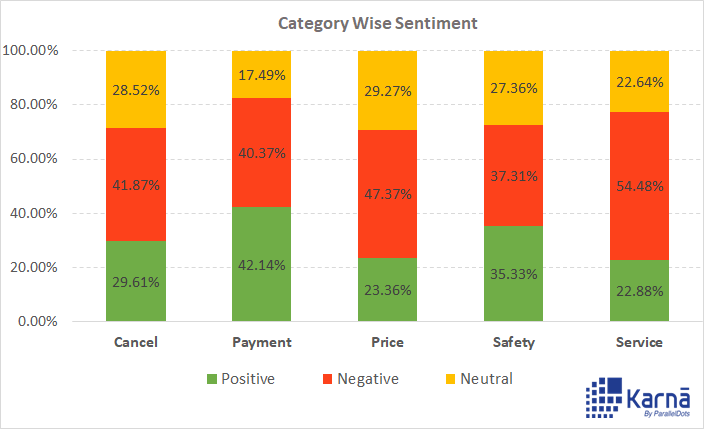 Category wise sentiment analysis
Category wise sentiment analysis
To understand real user opinions, complaints and suggestions, we have to again filter the unrelated Tweets(Spam, junk, marketing, news and random):
There is a remarkable reduction in the number of positive Payment related Tweets. Also, there is a significant drop in the number of positive Tweets for the category Safety(and related keywords.)
Brands like Uber can rely on such insights and act upon the most critical topics. For example, Service related Tweets carried the lowest percentage of positive Tweets and highest percentage of Negative ones. Uber can thus analyze such Tweets and act upon them to improve the service quality.
NEWS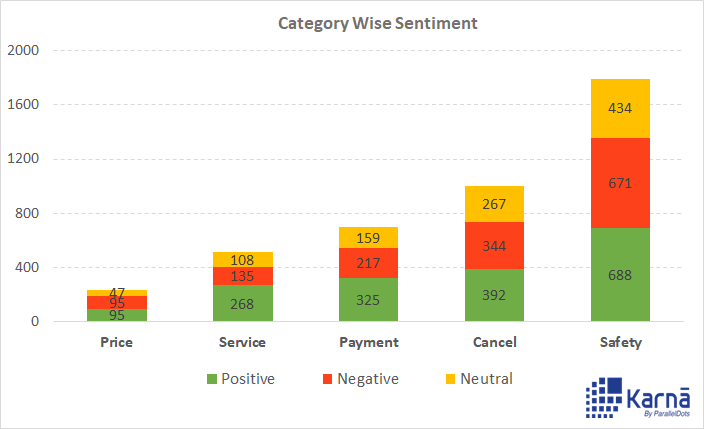 Sentiment Analysis for News Headlines
Sentiment Analysis for News Headlines
Understandably so, Safety has been the most talked about topic in the news. Interestingly, news sentiment is positive overall and individually in each category as well.
We classified news based on their popularity score as well. The popularity score is attributed to the share count of the article on different social media channels. Here’s a list of top news articles:
- Uber C.E.O. to Leave Trump Advisory Council After Criticism
- #DeleteUber: Users angry at Trump Muslim ban scrap app
- Uber Employees Hate Their Own Corporate Culture, Too
- Every time we take an Uber we’re spreading its social poison
- Furious customers are deleting the Uber app after drivers went to JFK airport during a protest and strike
Conclusion
The age of getting meaningful insights from social media data has now arrived with the advance in technology. The Uber case study gives you a glimpse of the power of Contextual Semantic Search. It’s time for your organization to move beyond overall sentiment and count based metrics. Companies have been leveraging the power of data lately, but to get the deepest of the information, you have to leverage the power of AI, Deep learning and intelligent classifiers like Contextual Semantic Search.
You can also use our Excel Add-in to analyze surveys without writing a single line of code. You can download the add-in from here.
We hope you liked the article. Please Sign Up for a free ParallelDots account to start your AI journey. You can also check demo’s of PrallelDots AI APIs here.
Read the original article here.
Automated Survey Processing using Contextual Semantic Search was originally published in Hacker Noon on Medium, where people are continuing the conversation by highlighting and responding to this story.
Disclaimer
The views and opinions expressed in this article are solely those of the authors and do not reflect the views of Bitcoin Insider. Every investment and trading move involves risk - this is especially true for cryptocurrencies given their volatility. We strongly advise our readers to conduct their own research when making a decision.
